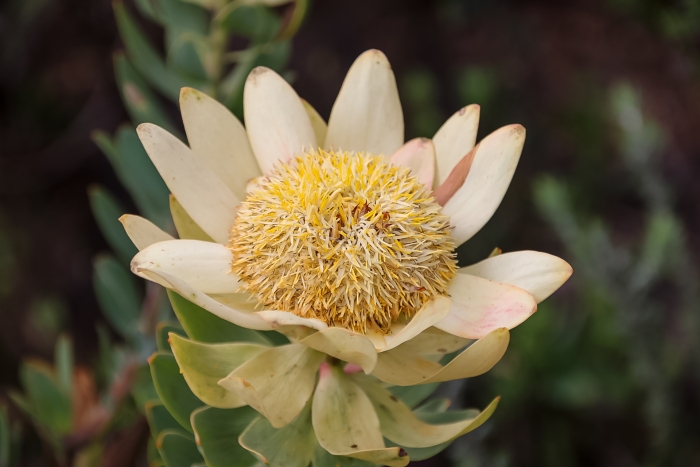Du Toit’s Kloof Conebush
(Leucadendron daphnoides)
Du Toit’s Kloof Conebush (Leucadendron daphnoides)
/
/

© isiz
CC BY 4.0
Image By:
© isiz
Recorded By:
Copyright:
CC BY 4.0
Copyright Notice:
Photo by: © isiz | License Type: CC BY 4.0 | License URL: http://creativecommons.org/licenses/by/4.0/ | Uploader: isiz | Publisher: iNaturalist |

































Estimated Native Range
Summary
Leucadendron daphnoides, commonly known as Du Toit’s Kloof conebush, is an evergreen shrub native to the fynbos biome in the Western Cape of South Africa, specifically in the Slanghoek, Du Toitskloof, and Stettynskloof mountains. This species thrives in a Mediterranean climate, characterized by wet winters and dry summers, often found on sandy and well-drained slopes. It typically grows up to 1.5 meters tall and has a similar spread. The conebush has a striking appearance with narrow, bluish-green leaves and bears yellowish-green flowers from July to September, which are not particularly showy but are interesting for their unique cone-like structure.
Leucadendron daphnoides is valued for its drought tolerance and architectural form, making it a suitable choice for water-wise gardens, Mediterranean-themed landscapes, and as a specimen plant in rockeries. It is also used in floral arrangements for its long-lasting cut foliage and cones. Cultivation requires full sun exposure, low water once established, and well-draining acidic soils. It is generally low-maintenance but can be susceptible to root rot if overwatered or planted in poorly draining soils. Regular pruning can help maintain its shape and promote bushier growth.CC BY-SA 4.0
Leucadendron daphnoides is valued for its drought tolerance and architectural form, making it a suitable choice for water-wise gardens, Mediterranean-themed landscapes, and as a specimen plant in rockeries. It is also used in floral arrangements for its long-lasting cut foliage and cones. Cultivation requires full sun exposure, low water once established, and well-draining acidic soils. It is generally low-maintenance but can be susceptible to root rot if overwatered or planted in poorly draining soils. Regular pruning can help maintain its shape and promote bushier growth.CC BY-SA 4.0
Plant Description
- Plant Type: Shrub
- Height: 3-4 feet
- Width: 2-4 feet
- Growth Rate: Moderate
- Flower Color: Red, Orange, Yellow
- Flowering Season: Spring
- Leaf Retention: Evergreen
Growth Requirements
- Sun: Full Sun
- Water: Low
- Drainage: Fast
Common Uses
Bee Garden, Drought Tolerant, Low Maintenance, Showy Flowers
Natural Habitat
Native to the fynbos biome in the Western Cape of South Africa, often found on sandy and well-drained slopes in a Mediterranean climate
Other Names
Common Names: Reusepoeierkwas
Scientific Names: , Leucadendron daphnoides, Leucadendron venosum, Protea conchiformis, Protea daphnoides, Protea coriacea,
GBIF Accepted Name: Leucadendron daphnoides (Thunb.) Meisn.